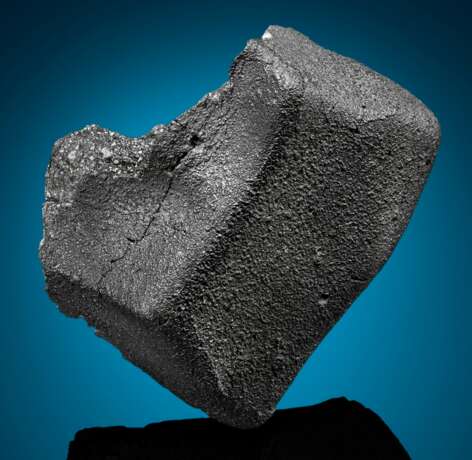ID 389962
Lot 19 | MURCHISON — 7 BILLION YEAR OLD STARDUST
Estimate value
$ 12 000 – 18 000
This fragment reveals both the interior and exterior of a specimen of one of the most coveted of meteorites. Charcoal briquette-like in shape, the muted monochromatic fusion crust provides a stark contrast to the grey matrix seen on the reverse. Clearly visible in the matrix are chondrules and white Calcium-Aluminum Inclusions (CAIs) which are — apart from submicroscopic pre-solar grains — the oldest matter mankind can touch. This pristine, exemplary specimen of Murchsion contains tens of thousands of organic compounds and may be related to the meteorite that introduced the precursors of life to Earth.
55 x 51 x 33mm (2 x 2 x 1.33 in.)
75.85g
On January 13, 2020 the Murchison meteorite made headlines yet again. This time it was not the result of the discovery of even more than the 70 amino acids and tens of thousands of organic compounds already found. Nor was it about further support for the Panspermia Theory of Creation, where a meteorite like Murchison delivered water and organic nutrients to Earth billions of years ago precipitating the commencement of life. This time it was the announcement that a specimen of Murchison contained the oldest particulate matter ever encountered on our planet. A grain of stardust in a Murchison specimen was determined to be about seven billion years old — about 55% older than the Earth and Sun. The dating methodology was performed by measuring extent of cosmic ray exposure of the grain, and the announcement made headline news all over the world.
It was at 10:58 am on September 28, 1969 — only about two months after Apollo 11 landed on the Moon — that a meteorite shower occurred over the town of Murchison, Australia. The labs that had been set-up to study Moon rocks were suddenly tasked with additional work when it was discovered that Murchison meteorites had a distinct aromatic odor. We now know that Murchison meteorites contain a variety of organic compounds including alcohols, aromatic hydrocarbons and fullerenes — the latter being a distinct form of elemental carbon with antiviral properties. And then there are the meteorite’s amino acids, the building blocks of proteins, essential to every cellular process in terrestrial organisms. Rich in carbon and water, Murchison is chemically primitive; it experienced alteration by water-rich fluids on its parent asteroid prior to impacting Earth. Coveted by both scientists and collectors, the last several decades have seen specimens of Murchison become among the most researched of meteorites with citations in scores of scientific papers. In 2010, an article in the Proceedings of the National Academy of Sciences announced that tens of thousands of unique molecular compositions were identified in a small section of a Murchison specimen. The study, by a team of nine European scientists, further determined that many of these organic compounds were present in the solar system before life started on Earth. This not only raises the question of whether meteorites played a key role in life's origins, but whether a meteorite similar to Murchison may have provided the nutrients enabling life to develop in other solar systems as well.
Christie's would like to thank Dr. Alan E. Rubin at the Institute of Geophysics and Planetary Physics, University of California, Los Angeles for his assistance in preparing this catalogue.
| Address of auction |
CHRISTIE'S 8 King Street, St. James's SW1Y 6QT London United Kingdom | |
|---|---|---|
| Preview |
| |
| Phone | +44 (0)20 7839 9060 | |
| Buyer Premium | see on Website | |
| Conditions of purchase | Conditions of purchase |




